Discovering a whitefly infestation on your indoor plants is no fun. You may think they’re just annoying, but those tiny white bugs can cause major damage to your beloved plants.
Since they can fly around, they could quickly infest all of your houseplants before you realize there’s even a problem. But the good news is that you can get rid of whiteflies on your plants, and it’s really not that hard.
Below I will walk you through everything you need to know, including how to correctly identify them, their life cycle, the damage they cause, and where they come from. Most importantly, I’ll share organic treatment methods that will eliminate them – FOR GOOD!
What Are Whiteflies?
Whiteflies are tiny bugs that feed on plants by sucking the sap out of the foliage. They mostly cluster on the undersides of the leaves, and they can attack many types of indoor plants.
These annoying pests are difficult to control once they get indoors, in both greenhouses and homes alike.
They multiply very quickly, and their population can double in a short time. Since they are so small, you probably won’t notice them until after your plant is infested.
What Do They Look Like?
As the name would suggest, they look like tiny white flies or moths. It’s easy to identify them because the adults will fly around frantically when you disturb the infested leaves.
Flip a leaf over and you’ll probably see tons of little white specks or dots (eggs and nymphs), and even more flies under there. Yuck!
But these aren’t the only pests that can infest your indoor plants. If you see white bugs, but they don’t fly around, then you probably have mealybugs, and here’s how to get rid of those.
Otherwise, if the bugs flying around your houseplants are black, then those are fungus gnats, and here’s how to eliminate them.

Their Life Cycle
The full whitefly life cycle takes about 3-6 weeks. There are several stages to it, but the 3 main ones are the eggs, nymphs, and adults.
In the right environment, they can reproduce fairly quickly. It takes about a week for the eggs to hatch, then another couple of weeks for the nymphs to mature into adults.
The adults only live for about a month, but the females can lay as many as 100 eggs during their short life span. Eek!
Whitefly Damage To Plants
Whiteflies harm a houseplant by sucking the juices out of the leaves, causing them to turn yellow and eventually drop off.
Both the adults and the nymphs feed on leaves, but the nymphs wreak the most havoc. So by the time you notice the adults flying around, they’ve probably already done some major damage.
A large population will cause severe damage to the leaves, and can eventually kill the plant. Although mature, healthy plants can sustain a heavy infestation longer than small or weak ones.
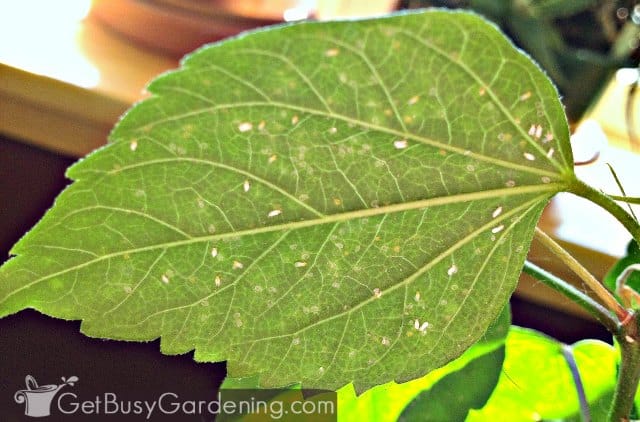
Where Do Whiteflies Come From?
It seems like these pests come out of nowhere. One day your houseplant is fine, and the next there are tons of bugs flying around, leaving many people wondering, what causes whiteflies in the first place?
Though they can come from almost anywhere, here are a few of the most common sources:
- Unknowingly bringing home a new plant that’s already infested.
- Using contaminated potting soil.
- Putting your houseplants outside during the summer.
- Bringing in fresh flowers, herbs, fruits, or vegetables from the garden.
- Through window screens (since they’re so small, they can easily crawl in).
Related Post: Where Do Houseplant Pests Come From?
How To Get Rid Of Whiteflies On Indoor Plants
Once you discover whiteflies on an indoor plant, you should take action to control the outbreak right away. Here are the first steps to follow:
- Isolate the affected plant immediately by moving it to another room.
- Wash your hands before handling any of your other houseplants.
- Check all of the surrounding plants, making sure to look under every leaf.
- Begin treating the infestation right away to get rid of it as quickly as possible.

5 Organic Whitefly Treatment Methods
There are several organic whitefly control options, so there’s no need to use toxic synthetic pesticides. Plus they aren’t as effective because bugs can build up a tolerance to these chemicals, making your problem even worse.
Always test any sprays on a few leaves before treating the whole plant, and be persistent in your fight. You can’t treat them once and expect the infestation to go away forever.
Related Post: Natural Pest Control Methods For Houseplants
1. Insecticidal Soap
Use an organic insecticidal soap, or make your own by mixing my homemade whitefly spray recipe in a clean bottle:
- 1 teaspoon of mild liquid soap
- 1 liter of tepid water
You can spray it on the leaves or use it to wash them. Be sure to focus on the undersides of the leaves, which is where whiteflies like to congregate.
If the plant is small enough, I will bring it to the sink or shower to wash it, then thoroughly rinse the leaves afterward to remove all of the suds. This will knock down the population very quickly.
2. Neem Oil
Neem oil is a natural insecticide that works great to eliminate whiteflies, and it also has a residual effect to prevent them from coming back. I buy it as a concentrate and mix up my own spray, here’s my recipe:
- 1 ½ teaspoons of organic neem oil concentrate
- 1 teaspoon of mild liquid soap
- 1 liter of tepid water
This mixture will kill the bugs, eggs, and nymphs on contact, and will also work to eliminate the population long-term. Treat your plant every few weeks until all signs of them are gone, and don’t forget to spray underneath all of the leaves too.
Related Post: How To Use Neem Oil Insecticide On Plants
3. Pruning
In addition to cleaning and spraying the leaves, you can trim off the most heavily infested ones and throw them into the garbage (outside the house).
This can help you get the infestation under control faster by eliminating many of the nymphs and eggs. Just make sure you don’t cut all of the leaves off your plant.
4. Yellow Sticky Traps
Whitefly adults will scatter and lay their eggs on other nearby houseplants, especially when you start treating the infested one.
So if you don’t control the adults, they will just keep moving around, and your problem will never go away.
One great method to try is hanging a yellow sticky trap from the top branches, or put a few in and around larger plants. You can also use them to monitor and prevent any future infestations.
5. Vacuum Cleaner
You could also use a handheld vacuum cleaner to capture the adults as they fly from the houseplant. Just be careful not to suck up the leaves in the process.
Gently shake the stem or branches to stir up the whiteflies, then suck them up as they flee. They move fast, so use a small handheld vacuum to make it easier to maneuver.
How To Prevent Whiteflies From EVER Coming Back
Once you’re successful with getting rid of whiteflies on your indoor plants, you’ll want to do everything you can to keep them from coming back. Here are a few long-term prevention tips:
- Check the leaves regularly for signs of bugs, I do this every time I water.
- Quarantine all new ones for a few weeks to ensure they don’t have bugs on them.
- If you put any or your houseplants outside, be sure to clean and debug them before bringing them back indoors.
- Use neem oil as preventive spray on any of your plants that have recurring problems.
Dealing with whiteflies on indoor plants can be difficult, but you can eliminate them. Whatever method you decide to use, you have to be diligent. They can be tough to get rid of, especially if you have several houseplants, but your persistence will pay off in the long run.
If you’re tired of battling indoor plant bugs, then my houseplant pest control eBook is for you. In it you will learn how to identify and kill all of the most common pests, and get my secrets to keep them away, FOR GOOD! Download your copy today!
Share your tips for getting rid of whiteflies on indoor plants in the comments below.


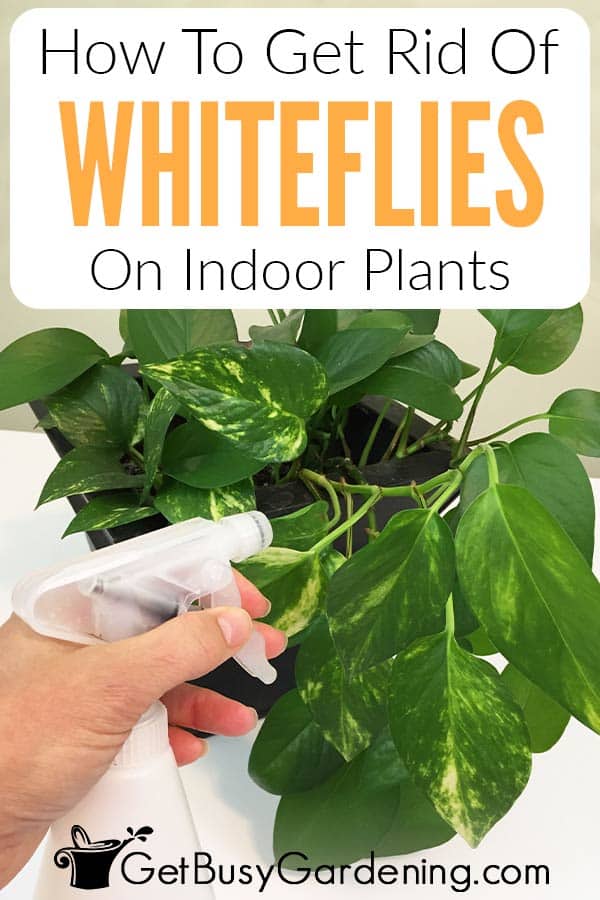
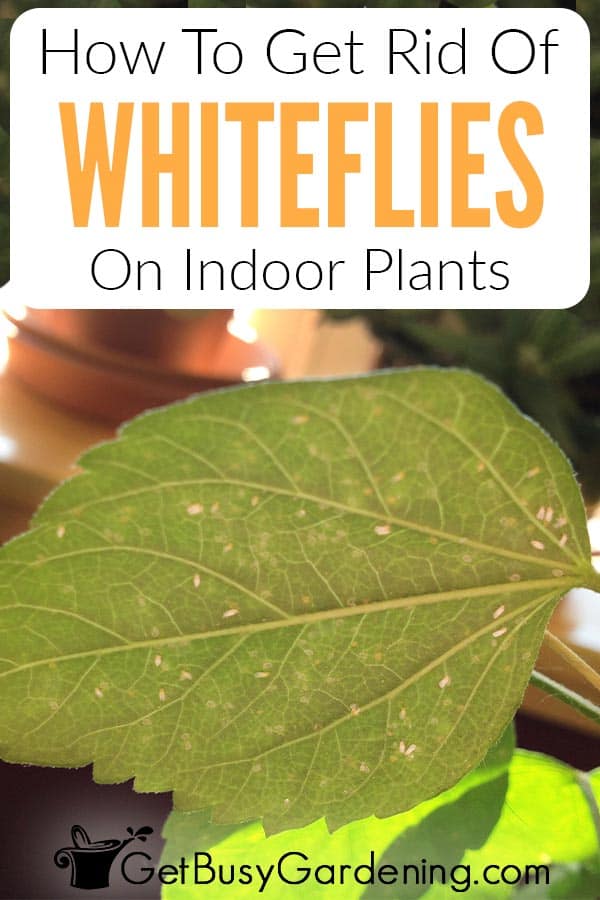
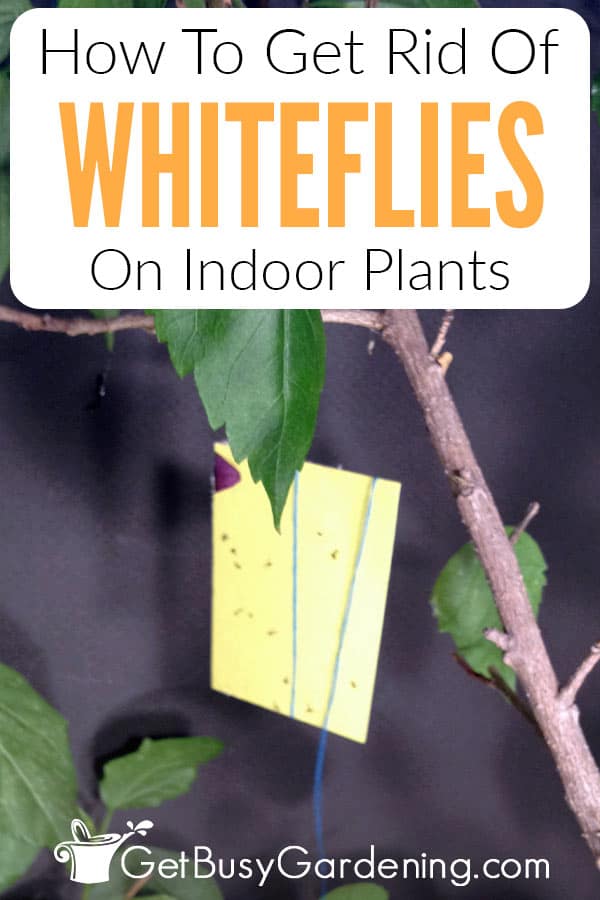
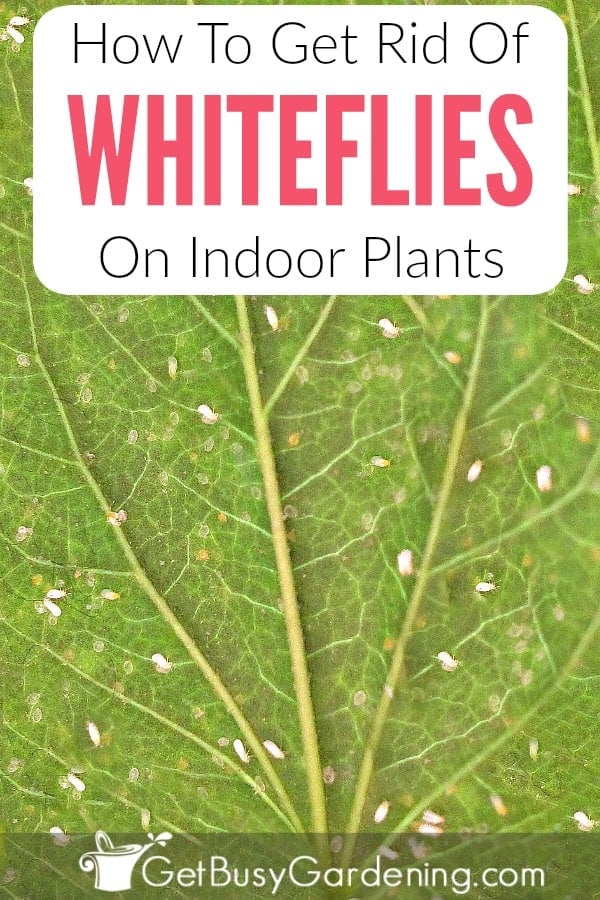



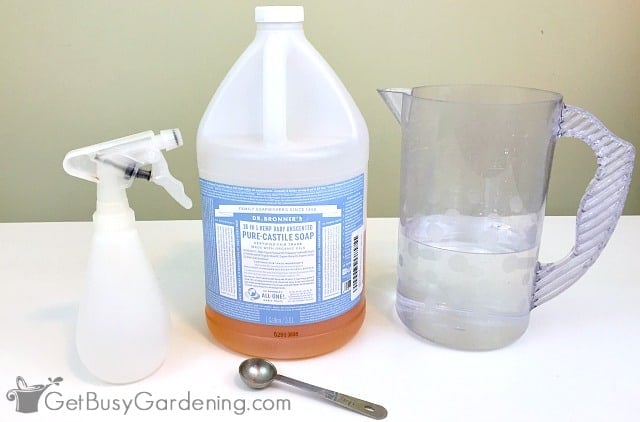

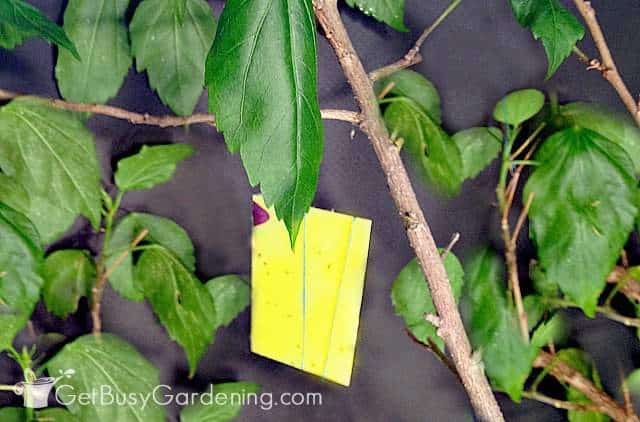
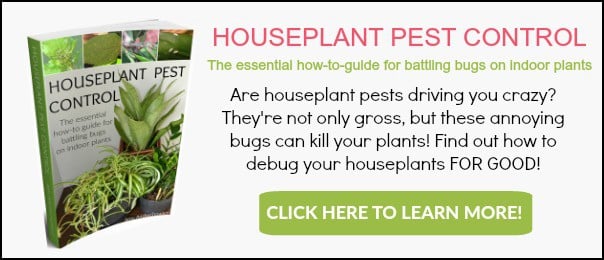

FaithMarie says
Recently I discovered that if the white flies is undisturbed under the leaf,
Let’s say ten all bunched up. I have a pan of soapy water closeby. I dip my hands in the soapy water then using my thumb on the bottom leaf and my forefinger on the top of the leaf, I smash the white flies. I dip the white flies in the pan of soapy water. Amazing, they don’t fly away. I must have killed hundreds using this method. But I have so many white flies though.
Amy Andrychowicz says
Awesome, thanks so much for sharing your method for killing the whiteflies on your plant. They are super frustrating, aren’t they!? I have had great success using neem oil to eliminate them for good, so you might want to give that a try if you haven’t already… How To Use Neem Oil To Kill Plant Bugs.
Piotr Seweryn says
i’ve got white little bugs on my Anthurium and Grapefruit plant. Whitefly are shown on the back of leaves, but my are only on top.
Amy Andrychowicz says
Those white bugs on top of the leaves definitely could be whiteflies. If they fly around when you disturb your plant, then you have a positive ID. Otherwise, it could be mealybugs. Here’s how to identify and get rid of those.
Andrea says
Have you successfully used neem oil to treat infestations on herb plants? I’ve found that it burns my sage leaves and possibly my mint leaves, but I currently have a whitefly and spider mite infestations on those same plants 🙁
Amy Andrychowicz says
I have never had whiteflies (or any other bugs) on my herb plants before, so I have never had to use neem on them. However, are you sure it’s the neem oil that is burning the leaves? Are you mixing it with soap? If so, then it may be the type of soap you’re using that is damaging the leaves. Spider mites also cause the leaves to look dried out and burned, so it could be them that’s causing the damage. Here are few articles that might help you out…
How To Use Neem Oil Insecticide On Plants
How To Get Rid Of Spider Mites, For Good!
Andrea says
I’m pretty sure its the neem oil though I could be wrong. I have mixed it with Dr. Bronner’s castille soap, which seems to be the recommended “gentle” option, and the sage leaves consistently seem to experience damage when I do. The spider mites unfortunately spread to my thyme plant (which is hardier than sage because it doesn’t have fuzzy leaves), so im going to try rinsing it with the soap solution and the spraying with neem oil and seeing how it withstands that treatment.
Amy Andrychowicz says
Bummer that the bugs have spread to your other plant, that’s super frustrating! Sometimes fuzzy-leaf plants are more sensitive to any type of spray, no matter how mild. So it certainly could be that is what’s damaging the leaves. Try spraying the mixture on a cloth to dampen it, then use it to wipe the leaves of your sage plant instead of spraying them.
stantt jernow says
Dear Any-
Just try it – the plants love, love, LOVE mothballs.
It keeps them nice and compfy.
Much better than Neem. Or than Whitefly traps.
And really easy to do. Thanks for carrying out the experiment Amy.
Amy Andrychowicz says
Thanks for your tips. I don’t have any whiteflies right now (thankfully!). But if they ever come back, I will keep this in mind.
Sarah says
I followed the article and sprayed the leaves of my pride and joy poinsettia. Now the leaves have all dried up, curled up and are about to start dropping off. It is totally destroyed and I am so sad as I have spent two years raising such a beautiful plant. White fly has gone, plant has died. Any way to bring it back to life? Thank you. ?
Amy Andrychowicz says
Oh no, so sorry to hear that your plant isn’t doing well. Unfortunately, poinsettias are very sensitive to sprays, and this is a very common response. That’s why I try to make a point about testing any type of spray on a few leaves before treating the whole plant. Some plants don’t like having their leaves sprayed, and doing so can cause more damage than the bugs. 🙁 The best you can do is treat it like you normally would, and hope it will recover. Here’s a detailed post about how to care for poinsettias that will help you out. I’m glad to hear you’ve gotten rid of the whiteflies though, and I truly hope your plant will recover.
stantt jernow says
DO NOT SPRAY !!!
Just put mothballs into the soil and your flies will be gone.
No mess, no fuss.
Amy Andrychowicz says
Interesting, I’ve never heard of using mothballs to get rid of whiteflies. It’s cheap enough to give it a try next time. 🙂
Nina says
Thank you for this insightful post!
My Zebra plant has white flies, but the leafs have a lot of ridges so I’m concerned of the spraying as it will trap the moisture longer. (but i can see the eggs on the ridges), Is it ok to spray the zebra plant? I have a white fusion calathea next to it so I’m also concerned about those leafs.
Amy Andrychowicz says
Oh no, sorry to hear your plant has whiteflies. Definitely test anything you plan to use on a few leaves before spraying it on the whole plant. If after a few days/week the spray didn’t damage the leaves, then it should be safe to treat the whole thing. Good luck!
Kellee says
Do I need to treat the soil or replant the plant?
Amy Andrychowicz says
No, whiteflies live and breed on the leaves, so there’s no need to treat the soil. Definitely don’t repot your plant either! Repotting is very hard on them, and can end up killing a bug infested plant because it’s already weak from the whiteflies. Just follow the steps above to treat your plant, and don’t repot it until all the bugs are gone.
robyn says
Will the mild liquid soap spray harm my African violet? It is flowering beautifully and looks extremely healthy apart from the whitflies.
Amy Andrychowicz says
I don’t recommend using any type of spray on African violets. They hate when their leaves get wet, and sprays can end up causing severe damage. Instead, I would use sticky traps to capture the adult whiteflies, then work to remove the eggs and nymphs by hand. I haven’t tried this with African violets before, but if it was me, I would try dampening a cloth with neem oil, then wiping a very light amount of it on one leaf to test and see how the plant handles it. Then I’d wait and week and do it again on the same leaf. If the neem oil doesn’t damage the leaf after two treatments, then I would wipe all of the leaves in the same manner. Continue treating it every few weeks until all of the whiteflies are gone. Good luck!
Didi says
Thanks for white fly fighting guide! Luckily, I’ve yet to have any on my houseplants, but they did take over my peppermint last year and my kale this year. I love the idea of using both sticky traps and the neem oil! I never considered that! 😀
Amy Andrychowicz says
You’re welcome! Hope the sticky traps and neem oil will get rid of your whitefly problem.
Suzie lacey says
White flies are killing my 3 ficus Benjamin trees in pots, I sprayed with bug spray from Home Depot but they won’t go away, what do I do? Should I cut the trees back? I’m at a loss?
Amy Andrychowicz says
What type of bug spray are you using? Whiteflies can become resistant to synthetic pesticides, so I do not recommend using those (especially inside the house!). I use organic neem oil to get rid of whiteflies on my plants, and it works great. Following the steps outlined in the post above will help you get rid of them for sure. Read the “How To Treat Whitefly Larvae & Eggs” section above for details about how to treat the plant, as well as my recipes for homemade insecticidal soap and my neem oil whitefly spray recipe.
Niko says
I’ve been trying to rid myself of these little white insects on plants for to long now! this post was so helpful. I have a little herb garden inside that I use when I cook and I’ve had whiteflies kill my favorite spearmint plant already.
Finally have the ammo to fight back!
Amy Andrychowicz says
Oh no! Sorry to hear you’ve been battling whiteflies for so long. Good luck getting rid of them, they’re so annoying! So glad I could help!
Ellie LaJuett says
I wish I had read this a few months ago. I brought a large 10 year old plant outside for the summer. It was totally infested with whitefly. I brought it in to get rid of the and and infected all my houseplants. I threw them all away. Thank you for this post. I learned so much!
Amy Andrychowicz says
Oh no!! Sorry to hear that a terrible whitefly infestation meant you threw out all of your plants. Hope you will try again with growing houseplants, they are fun to have! 🙂
Ellie LaJuett says
I have replaced some and I took cuttings from friends to replenish my favorite plants. I love live plants to get me through our dreary winter here in NY. I will keep reading your posts and hopefully can nip the problems in the bud and keep them happy and healthy!????
Amy Andrychowicz says
Yes, I totally agree about houseplants getting us through the dreary winters! I love being surrounded by green all winter long! Good luck with your plants, and I hope you keep those pesky bugs from taking over again!
Brandon Coppin says
I get them on my Mandevilla. Tried this and it worked. Thank you!!
Amy Andrychowicz says
Awesome, that’s great to hear! 🙂
Anonymous says
Can I cut my hibiscus plant back?
Amy Andrychowicz says
Yes! I cut mine back every fall when I bring it indoors.
PlantPostings says
Thanks for including the organic methods–even if they take a little more diligence and persistence. White flies are frustrating!
Amy - Get Busy Gardening says
You're welcome. I use organic methods on all my houseplant pests.
Stantt Jernow says
I have found a good method to completely prevent white flies and all insect pests on potted plants
Bury mothballs in the soil.
They don’t like it.
I use napthalene.
My chemist wife says it is least harmful to people.
No more bugs !
Especially good on Mandevilla.
Stantt’s method.
Amy Andrychowicz says
Thanks for sharing the tip. But just be aware that mothballs are not organic, and can contain toxic pesticides.
Grant Savory says
Hello, I’m Grant from Pittsburgh PA, and I loved your article and it helped me learn of my issues with what I think are whiteflies upon researching. I just noticed today actually that I had these tiny little worm-like creatures all over some of the leaves of my Hibiscus plant. I’ve had it for a couple years as an indoor plant, and just noticed this issue with these things. I found out they were whiteflies upon researching it, however I haven’t seen too many of them fly; just on the leaves crawling. So, I’m totally new to this issue but I read your care guide to get rid of them thoroughly and ordered traps, neem oil, and insecticidal spray so I can hopefully kill them. If you could give me any tips you feel would be helpful to me, that would be great. I hope the sprays I ordered will not have an adverse effect on my plant, but I guess I will have to try it and find out. I hope you can get back to me as soon as possible.
Amy Andrychowicz says
Yuck, sorry to hear your plant has whiteflies! The reason you’re not seeing any of them flying yet is because most of them are probably still in their nymph stage. They don’t fly until they’re adults, so you may see an explosion of flying adults in a week or so. Every plant is different, so yes, you’ll have to test the sprays out on a few leaves before treating the whole plant. Spray a couple of leaves, and let it sit for a few days to make sure there’s no damage. Good luck getting rid of them!